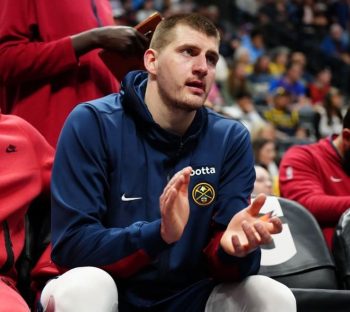NBA
The Timberwolves Are Pushing The Limits Of Process

Andrew Wiggins caught the ball at the top of the floor. As Noah Vonleh set a screen to his left, Wiggins sensed Eric Paschall’s momentum shift toward the pick and Willie Cauley-Stein position himself behind it. He quickly rocked the ball from side to side before before planting hard off his right foot, rejecting the screen for a clear path to the rim.
As Wiggins’ long strides creased the paint, Jacob Evans dug off the near wing to muck up his drive and Draymond Green left the far corner to meet him at the basket. Instead of kicking the ball out to an open teammate, the simple play that marked his headline-grabbing start to the regular season, Wiggins jumped to loft a tough runner over the outstretched arms of Green and a recovering Cauley-Stein.
The ball bounced twice on the rim before falling through, one of Wiggins’ 10 scores on a night he took 27 shots – and the Minnesota Timberwolves managed a paltry offensive rating of 98.1 in a loss to the lowly Golden State Warriors.
There were extenuating circumstances involved in the Timberwolves’ 11th consecutive loss, and again on Thursday when they broke the league’s longest losing streak by beating the Sacramento Kings in double overtime. Karl-Anthony Towns, after all, has been sidelined with a sprained knee since Dec. 18.
No one ever doubted his value to Minnesota. The gap in overall quality between he and his teammates might be bigger than that of any other franchise player and the rest of his roster, even accounting for Wiggins’ improvement this season. Towns is indispensable to the Timberwolves.
That’s been obvious for years, and comes as no surprise. But as Minnesota fully and steadfastly embraces the wholesale change in philosophy being pushed by Gersson Rosas and Ryan Saunders, it’s become readily apparent just how much the success of that shift relies almost solely on Towns.
The Timberwolves ranked 26th in three-point rate last season, and dead last during Tom Thibodeau’s first two seasons in Minneapolis. They made a concerted effort to abandon that old-school offensive approach during the offseason, going so far as to place stickers all over the floor indicating expected points per shot attempt.
It worked. Minnesota is launching 38.7 percent of its shots from deep this season, the league’s fifth-highest rate, per Cleaning the Glass. That 10 point uptick compared to last year’s number is the biggest in basketball.
The Timberwolves turned over half their rotation this summer, searching for players who fit the broad outlines of their revamped two-way style. But the entire league is always looking for shooting, especially on the cheap. Rosas just didn’t have the spending capital to lure highly sought-after free agents to Minnesota. Picking sixth in a two-player class, he was never likely to find an immediate contributor in the draft, either.
Those constraints are becoming increasingly hollow excuses for Timberwolves fans frustrated by their team’s emphasis on threes despite a roster sorely lacking in viable shooters. Minnesota is knocking down just 32.6 percent of its triples, second-worst in the league. It’s somehow even less accurate from the corners.
Jarrett Culver, connecting on an unsustainably awful 19.6 percent of his catch-and-shoot attempts, is the NBA’s worst three-point shooter among players taking at least 2.5 tries per game. Treveon Graham ranks second on that list, and Josh Okogie ninth. Shabazz Napier hasn’t played enough minutes to qualify, but is hitting 21.9 percent of his 4.3 attempts per game. Not even Robert Covington, bombing away at 32.9 percent, has been a semi-reliable long-range shooter.
But at least defenders pay Covington and Jeff Teague some measure of respect away from the ball. The same can’t be said for Minnesota’s other role players. If multiple players stationed beyond the arc aren’t guarded when they’re one pass away or on the weak side of the floor – like on the possession above against Golden State – the central advantage of the Timberwolves’ five-out offensive attack fails to materialize altogether.
Towns’ presence at least partially compensates for that spacing dynamic. Minnesota scores 17.2 more points per 100 possessions when he’s on the floor, per Cleaning the Glass, the highest mark in the league. Wiggins’ true shooting percentage is six points better with Towns playing next to him, too, evidence of the latter dragging would-be rim-protectors out to the perimeter. In seven games without Towns this season, Wiggins is shooting an ugly 18-of-35 from the restricted area, accuracy lagging far behind his season-long total.
It speaks to Towns’ transcendent talent that he’s proven a true offensive panacea this season. The Timberwolves’ system clearly suits him, and has helped turn Wiggins from a debilitating salary albatross to an abjectly positive on-court contributor.
Big picture, those are the takeaways from Minnesota’s sweeping transformation that really matter. The Timberwolves immense struggles of late, with and without Towns, wouldn’t be so disappointing if their hot start hadn’t artificially inflated expectations. They’re not a playoff team, even as the bottom keeps falling out of the West’s top eight.
The process indeed looms larger than the results for Minnesota during the early stages of its evolution. But if Towns and Wiggins aren’t consistently gleaning the benefits of their team’s newfound emphasis on three-point shooting, for how long should the Timberwolves’ awful shooters keep firing away with abandon before changes are made – to the roster, rotation, or offense?
Only Rosas and Saunders know the answer.













